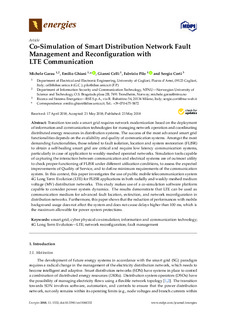| dc.contributor.author | Garau, Michele | |
| dc.contributor.author | Ghiani, Emilio | |
| dc.contributor.author | Celli, Gianni | |
| dc.contributor.author | Pilo, Fabrizio | |
| dc.contributor.author | Corti, Sergio | |
| dc.date.accessioned | 2019-09-09T06:57:55Z | |
| dc.date.available | 2019-09-09T06:57:55Z | |
| dc.date.created | 2018-11-22T16:21:26Z | |
| dc.date.issued | 2018 | |
| dc.identifier.citation | Energies. 2018, 11 (6), 1-17. | nb_NO |
| dc.identifier.issn | 1996-1073 | |
| dc.identifier.uri | http://hdl.handle.net/11250/2613843 | |
| dc.description.abstract | Transition towards a smart grid requires network modernization based on the deployment of information and communication technologies for managing network operation and coordinating distributed energy resources in distribution systems. The success of the most advanced smart grid functionalities depends on the availability and quality of communication systems. Amongst the most demanding functionalities, those related to fault isolation, location and system restoration (FLISR) to obtain a self-healing smart grid are critical and require low latency communication systems, particularly in case of application to weakly-meshed operated networks. Simulation tools capable of capturing the interaction between communication and electrical systems are of outmost utility to check proper functioning of FLISR under different utilization conditions, to assess the expected improvements of Quality of Service, and to define minimum requirements of the communication system. In this context, this paper investigates the use of public mobile telecommunication system 4G Long Term Evolution (LTE) for FLISR applications in both radially and weakly-meshed medium voltage (MV) distribution networks. This study makes use of a co-simulation software platform capable to consider power system dynamics. The results demonstrate that LTE can be used as communication medium for advanced fault location, extinction, and network reconfiguration in distribution networks. Furthermore, this paper shows that the reduction of performances with mobile background usage does not affect the system and does not cause delays higher than 100 ms, which is the maximum allowable for power system protections. | nb_NO |
| dc.language.iso | eng | nb_NO |
| dc.publisher | MDPI | nb_NO |
| dc.rights | Navngivelse 4.0 Internasjonal | * |
| dc.rights.uri | http://creativecommons.org/licenses/by/4.0/deed.no | * |
| dc.title | Co-Simulation of Smart Distribution Network Fault Management and Reconfiguration with LTE Communication | nb_NO |
| dc.type | Journal article | nb_NO |
| dc.type | Peer reviewed | nb_NO |
| dc.description.version | publishedVersion | nb_NO |
| dc.source.pagenumber | 1-17 | nb_NO |
| dc.source.volume | 11 | nb_NO |
| dc.source.journal | Energies | nb_NO |
| dc.source.issue | 6 | nb_NO |
| dc.identifier.doi | 10.3390/en11061332 | |
| dc.identifier.cristin | 1633916 | |
| dc.description.localcode | © 2018 by the authors. Licensee MDPI, Basel, Switzerland. This article is an open access article distributed under the terms and conditions of the Creative Commons Attribution (CC BY) license (http://creativecommons.org/licenses/by/4.0/). | nb_NO |
| cristin.unitcode | 194,63,30,0 | |
| cristin.unitname | Institutt for informasjonssikkerhet og kommunikasjonsteknologi | |
| cristin.ispublished | true | |
| cristin.fulltext | original | |
| cristin.qualitycode | 1 | |

